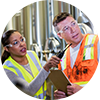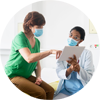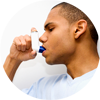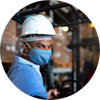Watch Concentra’s Telemedicine Webinar: COVID-19 Update and Concentra Telemed
In this webinar, you will learn about:
- The Impact on Business of COVID-19
- How Telemedicine Can Help
- Workers’ Compensation Myths About Telemedicine
- Key Considerations for Implementing Telemedicine
- An Overview of Concentra Telemed®
- Q&A
Presented by:
John Anderson, DO, FACOEM, chief medical officer, executive vice president
Lisa Figueroa, MD, FACEP, vice president of medical operations, national medical director of health information technology, and national medical director of telemedicine
Megan Hart, client engagement manager
Host
0:01
Hello, everyone, and welcome to the Concentra webinar, “COVID-19 Update and Concentra Telemed®.” Today’s webinar will be presented by Concentra’s Chief Medical Officer Dr. John Anderson, Dr. Lisa Figueroa, national medical director for telemedicine at Concentra, and Megan Hart, client engagement manager. At the conclusion of the presentation, we will have a 10-to-15-minutes Q&A session. You can submit your questions throughout the presentation. During the Q&A, we will answer as many questions as possible within the time allowed. A recording of the webinar will be emailed to you after the presentation so you can listen to it again at your convenience. Dr. Anderson, we’re ready to begin.
Dr. John Anderson
0:48
Thank you very much. Welcome, everybody. We’re glad you joined us today. I think we have some information that you will be very interested in and find helpful in traversing the path over the next couple weeks that we are guiding through with the coronavirus and the impact that it has on all of us. So the agenda is up there on the screen:
- COVID-19 business impact
- Why telemedicine?
- Workers’ compensation telemedicine myths
- Key considerations for telemedicine implementation
- About Concentra Telemed
- Q&A
1:13
We’ll go through each of these topics one-by-one, with the biggest focus, of course, on telemedicine, given that telemedicine is the premier way to distance ourselves in this environment while still being able to provide the care that is needed to get your employees back to work or to keep them working, especially those who are part of the critical infrastructure of the company. It has always been Concentra’s goal to improve the health of America’s workforce. This is an extension of what actually began several years ago when we initiated our telemedicine platform. So, if you switch to the next slide.
COVID-19 update and business impact
The current situation (4.2.2020, 1 p.m. CDT) is that we are approaching approximately one million patients worldwide that have been affected by the coronavirus and about 250,000 or so of them are in the United States. We’ve just exceeded, according to Johns Hopkins’ data, 50,000 deaths. Now, comparatively speaking, when you look at the annual influenza rates, especially the death rate, that’s not an exceedingly large number.
2:39
But the contagiousness of this virus and the severity of the illness, especially as it affects those people who are immunocompromised or of advanced age, is much greater than what we experience with influenza and the case fatality rate is significantly higher. It looks like it’s going to land about six times higher than the case fatality rate for a typical influenza season. So, on this slide, there’s nothing that you probably don’t already know or are experiencing. Concentra is going through the same issues and challenges as most of you. We’re trying to keep all of our centers open. We’re trying to keep our staff safe so they can care for your employees and keep them safe while providing the necessary services to keep the critical infrastructure moving forward.
3:38
We have about 3,000 clinicians – medical and therapy – at Concentra and a number of them are subject matter experts in various fields. In particular, the one of the most interest here, is infectious disease and travel health. We have been very assertive and aggressive in terms of preparing for this by developing a Coronavirus Task Force about two months ago. That Coronavirus Task Force and those members have been working every single day keeping up with the CDC and World Health Organization, travel advisories and so forth so that we can stay ahead of the challenges we’re now facing. Next slide please.
4:31
Probably the best area for you to be able to gain information that is current is cdc.gov. You can also go to Concentra.com where we have a specific link to that and to some of our own information for businesses and employers. But the cdc.gov site has a specific link to information for businesses and employers to help guide them through this crisis.
COVID-19: How employers can reduce risk in the workplace
5:08
If I could say one thing today that is of importance in terms of stopping or mitigating the spread of this virus, it is this. Keep your employees who are sick at home. If any employee calls and says, “I’m not feeling well. I have a sore throat. I have a fever. I have muscle aches and pains. I’m coughing and short of breath,” tell them to please don’t come to work. Actually, they should be self-monitoring at home and, if their temperature or symptoms begin to develop, they should be calling in to you and saying, “I can’t come in to work. I’m starting to run a fever. I don’t feel well,” and you certainly want them to stay home to ensure that the rest of your employees are safe.
6:02
It’s necessary for every employee and employer to understand respiratory etiquette and hand hygiene. We had a cover the cough program at Concentra within our centers for the past several years, especially during the active flu, cough and cold season. This program instructs patients on how to cover the cough and reduce the risk of spreading viral diseases to both our patients and our colleagues. Of course, regular cleaning of the work environment is something that is highlighted on the CDC site. Simple products like Lysol wipes, which most of us probably have seen, but maybe never have read about how that particular product and most other household products for cleaning surfaces are able to kill the coronavirus, which is the common cold type virus, this one currently being a novel virus – in other words, one that has never appeared before and that has a different genetic structure. So cleaning the work environment, creating an infectious disease response plan and sharing that with your employees, and just making sure that your sick employees notify you in advance and don’t come into the office and tell you when they get there that they are sick. So, the next slide.
7:29
COVID-19: Concentra’s response
This basically is what Concentra has been doing to prepare for, as we saw unfolding a couple of months ago. This is as we have been watching and observing the changes at the CDC and the World Health Organization so that we could be compliant with all of the guidance that’s being given to us. We established, as I said, a Coronavirus Task Force, which is multidisciplinary approach to this, including the medical group, our operations group, and procurement group so that we have enough supplies for us. PPE, that’s personal protective equipment to keep our staff and your employees safe. Other members on the Coronavirus Task Force include our attorneys, our communications experts, and several others. So, again, they meet daily, even several times a day and update our documents, which are all housed on Concentra’s intranet so we are able to update them and are staff, our practicing clinicians are able to get the most updated information that they possibly can.
8:45
We’ve been working very closely with local health departments. It’s interesting working with the health departments because we get different answers from different health departments across the country as different states develop their own regulations and rules to handle the crisis. We’ve had to have our local teams be our connections to the health departments and, of course, our national team is following the CDC and the World Health Organization guidelines. Always, the local health departments’ rules and regulations supersede anything we place our there in our own protocols. We’ve developed enhanced cleaning protocols at our centers, and we have also developed a risk of exposure categorization to identify any of our centers in areas where the coronavirus is a hot zone so we can increase security at those centers. Next slide please.
9:55
Our entire goal here is to protect your well or healthy employees and minimize any potential exposure to them, as well as to our own staff. That starts when your employee may walk up to our door. We have signage on the door that is a form of clinical triage that tells individuals coming up to the door that if they have a fever, cough or other symptoms, they should call the center from outside the center before coming in. We have a mandatory screening questionnaire at every center, which is an enhanced version of our triage. If and when we identify somebody who has signs or symptoms of the coronavirus, we immediately segregate them from our other patients and place them in an isolated room as quickly as possible. And, again, we’ve had significant cleaning and infection control processes, if and when we do encounter those situations.
10:58
Every center has notified employers that we do not test for the coronavirus at our centers. We’re not able to test, and we’re not able to treat because there is no Food and Drug Administration (FDA) approved treatment for the coronavirus in the outpatient setting at this time. We’re watching for that to change as medications like hydroxychloroquine may be approved for that. Of course, we’ve implemented our cover the cough policy at all of our centers, and we’ve implemented social distancing in our lobbies and waiting areas for our patients. Finally, with more than two years of experience in the telemedicine arena, we are encouraging – whenever possible – for our patients to be seen via telemedicine. Our clinicians and our centers are now set up for every one of them to be able to provide telemedicine services for our rechecks. So, if a patient comes in with an injury evaluated by the physician, and the physician feels that the follow-up visit is compatible with a telemedicine visit, they’ll walk through the process of setting up the patient at that time to ease their way into a telemedicine visit for a recheck rather than coming back into the center. In this way, your employees can get care from work or home with no need to visit the center unless complications arise or services are needed that cannot be provided via telemedicine, and we have strict protocols around those, as well. We’ve also established return-to-work evaluations for individuals who have had COVID-19 or who, for other reasons, have been out of work and are desiring to get back into the workplace, when the employer wishes for them to have a fitness for duty evaluation.
12:59
So, we’ve expanded what was a small group of telemedicine physicians in the company to making telemedicine available from all of our clinicians across all of our centers throughout the day. With that, I will turn it over to Dr. Figueroa.
Dr. Lisa Figueroa
Why telemedicine?
13:19
Thank you, Dr. Anderson. This slide says, “Why Telemedicine?” I think it's probably best stated, “Why Not Telemedicine?” This is true especially today with the COVID-19 pandemic. We know that you cannot watch the news, read the news, look at CDC websites or anywhere you’re looking without seeing the words telemedicine or telehealth. They're all going to be plastered over all of the reading material regarding COVID-19 – and for good reasons. When we think about the opportunity to be able to serve our patients who need injury care and who are going to be evaluated for COVID-19 exposure under workers’ compensation, the last thing they want to do is to have to go to a center and potentially get exposed. Although as Dr. Anderson has stated, we have put together a very strict protocol, very strict procedures within our centers to keep our staff and our patients safe. A lot of folks want to have their visits from home. Concentra Telemed has been live for about three years now, and we've been doing an extremely good job at workers’ comp injury care. Now, we’ve expanded, as I mentioned, to COVID-19 workers’ comp cases, and we're currently seeing those in the dedicated core group. As Dr. Anderson mentioned, our center clinicians are also seeing telemedicine rechecks, their own rechecks, and the COVID-19 return-to-work visits.
14:58
Next slide. Again, why not telemedicine? Patients are asking to be seen via telemedicine for their care. We have access and convenience for the patient. They just have to have a smartphone, a tablet, or any web device with a camera and a speaker to be able to have an encounter with a clinician. They can access telemedicine from anywhere. It can be from home or their workplace, if that’s where they choose they want to have their visit from. There’s no need to drive to a center. When we talk about cost, I think the reason this is on the slide is because typically what we are seeing in telemedicine are relatively minor work injuries. So when you look at reduced case duration and improved productivity, that’s because they don't have to leave the workplace. Those cases are typically shorter in duration and, therefore, the cost may be reduced. Again, we’ve been talking a lot about reducing the risk of exposure for patients, and telemedicine offers that opportunity with the virtual visit.
Common questions about telemedicine
16:13
A lot of questions were raised prior to the COVID-19 pandemic about what kind of injuries can we see via telemedicine and workers comp and particular injuries. And again, I mentioned that they are relatively minor. I'll speak to that in more detail later on in the presentation.
Can an adequate evaluation be made via video?
The answer is yes. This is one of the most frequently asked questions of me when I present on telemedicine nationwide. A video examination between the patient and the clinician is self-directed, which means that the clinician can ask the patient to present or demonstrate or show the injured part that we can certainly look at it to see if there's swelling or ecchymosis, which is bruising. We can ask them to do range of motion or to palpate at various depths. We can do grip strength if it's wrist. We can do gaits for lower extremity injuries. And I don't need to go on. I think it's fairly obvious that a lot of this examination can be done via visualization and by asking the patient to perform certain functions. The clinician is able to make a very good interpretation of the results and document them, resulting in a fairly comprehensive physical examination.
What happens if additional visits are required?
When workers comp telemedicine first came out – about three years ago for us – the question was, can we just have the initial visit via telemedicine and then all subsequent visits would be brick-and-mortar. We took some time, and it took some time, I think, for people in the marketplace to say it makes sense that, if it’s a telemedicine injury that’s appropriate initially, then why wouldn’t we just continue the care via telemedicine, and that’s what we do today. Granted, if patients are not progressing as they should, if they are worsening, if the mechanism of injury is significant and there is some concern or if the clinician doesn't feel like, for that particular injury, that an adequate examination can be done for a particular injury and mechanism of injury, then absolutely we would ask that those patients come to the center for a hands-on evaluation.
18:37
How secure is telemedicine for injury care?
It's very secure. Concentra Telemed is run on a video platform that’s HIPAA-compliant. We do not put any of the patient’s information on the video platform. Everything is documented in our EHR (electronic health record) so no private information is put on the video platform. It's just a secure for us to have a video visit with a patient.
Legal risks?
There are no legal risks that we are aware of. We've certainly have not had any, knock on wood, any legal issues to date and, again, we've been live for three years. So, it’s a nice way to have a telemedicine visit, just another way to deliver the same quality care.
Is it easy to implement?
Yes, it is. Megan will speak to that a little bit later in this presentation, but it is certainly quick and easy to implement.
Will employees use it and like it?
Yes, and we have data over the years to show that employees love telemedicine. This, again, is because of the convenience. They can access it from anywhere they want to have a visit. They have the privacy and the one-on-one with just them and their clinician talking about their injury and their treatment plans. Our ratings have been consistently averaging four-point-eight out of five stars. We know this because, on that video platform, they can rate us. We have significantly high ratings. Employees do like using it. Can I use telemedicine to screen for COVID-19? We are doing these visits today. These were our workers’ comp-specific injuries in our dedicated core group of telemedicine clinicians. And, as Dr. Anderson mentioned, we are doing COVID-19 return-to-work screening evaluations in our centers today.
Workers’ compensation telemedicine myths
20:38
Let’s turn to common myths about telemedicine. The first is that telemedicine is only to be used for first aid cases. That is myth number one. We do see cases that are relatively minor, but some of these patients will require modified duty or work restrictions based on what their jobs descriptions signify. So they may have to be put on modified duty. Some of these injuries, the repetitive use injuries that we see, may require some physical therapy to help get that patient back to their baseline and progress that case forward. Some will require an x-ray. We can do that and still see the patient back in telemedicine. So, beyond first aid, certainly we see this. Myth number two. I already mentioned about the physical examination; a fairly comprehensive exam can be done and documented. Again, myth number three, I also focused on how the entire case can be managed via telemedicine depending on patient progression.
Key considerations for telemedicine implementation
21:46
Key considerations for telemedicine implementation. We talked a bit about this already. The equipment is HIPAA-compliant. Video and audio are required because our visits are all audio-visual with the patients. It's important that we support workflows that are consistent with our Concentra centers and with what employers are expecting us to do. Telemedicine supports the use of electronic medical records so that you can maintain a continuum of that patient’s care, and it is available to all of the clinicians that do treat that patient across the continuum. Continuity of care is important. We strive for that but, on occasion, we will see somebody at 1 a.m., and they don’t want to have their recheck visits at 1 a.m. going forward. So, there may be some discontinuity in those cases by the patient’s choice, but all of the records are in the EHR, and all clinicians have access to that information. We have actionable reporting and 24/7 support, 365 days a year. Our workflows, as I mentioned, are all supported by our Concentra workflows today and our employer expectations. As for the experience of the providers, all of our telemedicine clinicians are Concentra-trained and Concentra employees. No 1099 (independent contractors). They all follow our clinical model and have the education of our occupational medicine and our occupational medicine expertise.
23:19
Take the communication. The beauty of Concentra Telemed is that the communication occurs exactly as if the patient had presented in a brick-and-mortar facility. We use our same registration, our same EHR, and we are able to communicate results via our employer portal. So all that information and communication occurs exactly as it would in a for an in-person evaluation. Next slide.
Focused implementation enables use
23:52
We talked a little bit already about how easy it is to implement. The most important thing is the engagement on the employer side and making sure that the folks are planning for telemedicine. They need to make everyone aware through education of what's to come and how patients will access telemedicine for their care. It's building awareness within that organization so that everybody feels comfortable with the process and joining a telemedicine visit. Patient experience. Again, telemedicine is a very user-friendly approach. Guidelines and instructions are easy to follow so that they don't have any difficulties when they first join the platform to the see a clinician in Concentra Telemed. Monitoring and reporting are very important. We have lots of data that we produce from our telemedicine visits, similar to what reports you would get if we were seeing those patients at our centers. Same processes. Same communication. Same reporting capabilities.
Now, I will turn it over to Meagan.
Megan Hart
About Concentra Telemed
27:41
Next slide please.
Concentra telemedicine can be accessed by downloading the app or going to the website. It is available 24/7 in 38 states currently. This platform can be accessed for new injuries, injury rechecks, and virtual physical therapy. As Dr. Figueroa said, this is a HIPAA-compliant software. We do not store any of the patient's private health information. That's all stored on our electronic health records and all the video visits are not recorded. Everything is deleted at the end of the day to protect the Integrity of the visit for the patients.
Next slide please. It is available 24/7. They can receive care at home, at work or on the road. We just ask that the vehicle is not moving if they are in that vehicle. They don't have to arrange transportation to or from a center or find someone to cover a shift. These video sessions require minimal wait time and no interruptions. We do take down all of the patient’s information prior to the visit so if Wi-Fi does go bad or the video session does disconnect, we can re-engage with that employee to get the visit restarted to complete the visit with the clinician. You have a nationwide health network of Concentra clinicians with fast access to appropriate care. Like I said, you can connect using a computer with a camera and microphone enabled or laptop or by downloading the app on a tablet or smartphone, both Android and iPhone. The care quality is the same as that you would receive at one of our Concentra medical centers. These are Concentra clinicians who are well-trained and skilled in delivering care for occupational medicine injuries and the ability to deliver care for choice. We like to say that they have a great website manner. We know how to manage the claims and cost. We want to keep those employees at work for better productivity. The more hours that they are in work, they are getting better. We're seeing fewer visits to the emergency department or urgent care visits. We want to keep them out of emergency departments even more than ever now.
27:17
Case durations are drastically shorter. We’re seeing around seven or eight days for a case duration and an average of two visits with the clinician, and we’re able to generally close out cases. We're seeing about a good chunk of the visits actually starting telemedicine and ending in telemedicine and never having to set foot in a bricks-and-mortar facility. So we're able to close out that case effectively via telemedicine, keeping in mind that injuries appropriate for telemedicine would be the more minor medical injuries. Like Dr. Figueroa noted, these are HIPAA-compliant visits via the platform. They are not recorded. We store that patient health information in our HER, the same EHR that we actually use in our Concentra medical facilities. That makes transitions to and from one of our Concentra facilities very seamless. The video visits are not recorded, which patients who love to hear. They want to have that secure stable visit with the clinician sharing that patient health information, and so, this puts them at ease.
28:17
Next slide please
So telemedicine promotes a medical cost savings for the employers by taking less time away from work for that injured employee. When you think about transportation times to and from the facility, potential wait times to see the clinician, and then travel times back to a facility, telemedicine reduces those times. It also eliminates an emergency department visit, which now reduces the risk of COVID-19 exposures as well. We're not overwhelming the health care system. We can tell an employee, hey, your injury is appropriate for telemedicine, and we can get you in front of a clinician who is skilled in occupational medicine right away. Generally, the employee will say yes, that sounds wonderful. They just want to speak to a clinician. The employer does not have a need for the PPE equipment that is already in short supply and high demand. We want to preserve that for the people on the front lines. So how does it benefit those employees? They have access to quality health care for work injuries, employer services, and rechecks, and return- to-work evaluations, and also physical therapy now, as well. We can do these screens for COVID-19 and provide options for self-care and refer critical patients when needed. Dr. Figueroa, back to you.
Dr. Lisa Figueroa
About Concentra Telemed
29:35
Thank you, Megan. So I had mentioned earlier about appropriate injuries for telemedicine and that they are relatively minor. So we're looking at grade one and two upper and lower extremity sprains and trains. Those injuries are by far the most common injuries that we’re seeing in telemedicine for workers’ comp injury. We also can see minor burns. Neck and back strains and sprains are also very commonly seen in telemedicine and, again, these are injuries based on mechanism that's not significant and where they don't have any significant limitations of movement. We see many contusions, contact dermatitis, different tendonitis and repetitive use injuries, and carpal tunnel syndrome. Bloodborne pathogen exposure is one of our most popular use cases for telemedicine. You think about the patient that’s very anxious and they want to get to a clinician right away. We can see them, and we can order their labs and get them back and recheck them right away. We can manage the entire case via telemedicine. Now again, I have mentioned that we are also seeing COVID-19 workers’ comp cases as well. Next slide.
30:48
So, we mentioned all of these things again. I think one of the most important messages here is that Concentra Telemed is easy to access. It allows for the patient to have a virtual visit. That's a quality visit with a clinician. They just need an internet access, Wi-Fi access and a device with a camera and audio, a valid photo ID, and an authorization to treat from the employer. So access to Concentra Telemed is through a website address, www.concentratelemed.com. Or you download the Concentra Telemed app in the Google Play store or Apple Store and that gives you access to one of our telemedicine clinicians. Back to you, Megan.
Megan Hart
About Concentra Telemed
31:24
Thank you. So everybody always asks, how do you bill? What is the cost for a telemedicine visit? We bill at usual and customary fee schedules, depending on the state. We do not have the ancillary charges, generally. So we put a modifier on the bill, so your TPA, insurance company, or bill reviewer knows that it is a telemedicine visit versus an in-clinic visit. They are very familiar with receiving these bills and able to get them to the right people appropriately. So the same CPT codes would allow the same treatment they would be able to provide in clinic. This is also based on the clinical care delivered, the injury type, and the service level provided by those clinicians. We don't charge any contract or implementation fees, or any technology fees. We do have language services available for over 200 languages. So, if your employee has a primary language other than English, we're able to provide those translation services. We do have some individuals within our telemedicine team who are bilingual in Spanish, so we don't always have to engage that translation service. But if we know ahead of time that we need to engage language services, we would be happy to do that and provide that translation for your injured employee.
32:55
Next slide please. Next you will see our employer portal. We would like to know that you're interested in telemedicine and we will get you signed up for our Employer Portal. This is where you would retrieve all of your post-visit documentation – your return-to-work, referrals, missed appointment documentation. Everything would be sent here via the HIPAA-compliant Employer Portal. As you can see on the report, it will state the patient's name, diagnosis, next steps, follow-up care and, if they have any modified activity duty statuses, those will be listed as well. You will know the state that the injury was treated in. That will be listed at the top and the physician that the patient actually treated with. We can provide a no-show report, as well. These reports all come within a few minutes, about 10 to 15 minutes, once the visit is complete, these reports come right to the portal, so you can retrieve that information appropriately. We can set up additional users, so if you have location-specific contacts, they'll receive that information in real time about their location and their injured employee. Next slide please.
34:02
So as you will see in front of you, these are the states that telemedicine is available in. We are doing the rechecks and COVID-19 return-to-work evaluations in every state where we currently have a Concentra medical center. The only states where we do not provide initial care 24/7 or at all, excuse me, are the states you can see here, Alabama, Arkansas, Idaho, Mississippi, Montana, Nevada, New York, North Dakota, South Dakota, Washington, Washington DC, which will be coming later this year, West, Virginia and Wyoming currently So if you have any questions on the state, you will see that in front of you. I will now transition this to the next slide, please.
34:44
There are many things I want you to keep in mind. Launching telemedicine for your employees at your workplace is not difficult. If you can identify a private location for that injured employee to have their visit, that makes a really big difference on the experience of the telemedicine visit for the injured employee. You don't want them having to do their visit in front of their colleagues in a break room and that they have an injury on a lower leg, or they may be asked to roll up their pants leg and show that to the clinician. You want to make sure they feel as though they're in a private space. Sometimes the employee will even identify that space and do their visit in their car or step away from the building. Think about the device that you want the employee to use. If you have a lot of your employees in one large location and you can set up a desktop or a kiosk, that works great. They can do their initial visit there or they can do their follow-up visit from home. That is up to you within your employer guidelines. Many employees just prefer to use their own personal devices. They feel as though that's very secure and private right there and it's handheld. There's no need for them to download the app prior to an injury. It takes just a few seconds to download from the Google Play or App Store.
35:58
You will want to check the website with your IT team by going to www.concentratelemed.com on your laptop or desktop computer that you're going to use. You can run the “Test My Computer Functionality” in Google Chrome or Firefox, and it will tell you if there are any firewalls or issues that will block your computer from running the video system for Concentra Telemed. One of the biggest things is communication – letting your leaders and supervisors know that telemedicine is going to be available. That way, when and if they do have to offer it to the injured employee, they are your boots on the ground, and they can help educate those employees on what the benefits are of telemedicine, specifically for your industry and your company. This will also give you a higher rate of adoption. They will be your cheerleaders, and they will make sure that the employees are comfortable and getting them over to telemedicine appropriately. You can do email blast or webinars. My biggest recommendation is doing whatever your internal process is when you roll out a new opportunity within your organization. Follow suit with what employees are used to seeing with that type of communication and they will adhere to that. My other recommendation is that five-to-seven touch points are generally appropriate to get the message out, to let them know that telemedicine is going to be available and some of the benefits. So, if you have safety huddles, share the information briefly there or if you have morning meetings, monthly calls, you can share it there.
37:22
We have flyers. We have distribution materials at our website. You're welcome to download and utilize all these materials. There are two custom videos that are about three-and-a-half minutes in length. Those are great resources to share with your employees or supervisors and managers on what to expect during a telemedicine and telerehab visit. Please let your TPAs, payers, and nurse triage companies know that you're interested in telemedicine. We work with many of them already and we're happy to facilitate that conversation to get things set up on their end. Devise an effective plan that streamlines exactly what you already do internally within your injury care processes. Don’t think that you're doing anything new. You're just adding an additional access point to care for wherever you may have previously had first aid or urgent care. You are just adding a telemedicine as an additional access point. Employees love to hear that you're giving them that service. Engage that workforce. Like I said, use those videos, use the materials on concentratelemed.com. This is a great opportunity to share that marketing material and get that in front of your employees. We're happy to support you in those endeavors. So now I'm going to pass this to our host for the Q&A session. Thank you.





